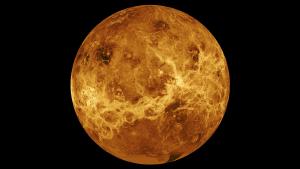Blog
The Tides That Bind
21 April 2022
 NASA/JPL-Caltech
NASA/JPL-CaltechOf the thousands of exoplanets we’ve discovered, most of them closely orbit red dwarf stars. Part of this is because planets with short orbital periods are easier to find, but part of this is that red dwarf stars make up about 75% of the stars in our galaxy. This propensity of close orbiting planets has some pretty big implications for “potentially habitable” worlds, not the least of which is that most of these planets are likely tidally locked to their star. Or so we’ve thought.
Tidal locking can occur when a smaller body closely orbits a larger one. The Moon is a good example of this. The orbital period of the Moon and its rotational period is the same, which is why we only see one side of the Moon from Earth. This is caused by the tidal forces of the Earth.
Earth’s pull isn’t uniform across the Moon. It’s a bit stronger on the part of the Moon closer to Earth, which distorts the Moon’s shape just a bit. In the past, the Moon rotated at a different rate than its orbit, which meant the tidal forces kept causing its rotation to slow down. Eventually, the Moon’s rotation slowed to match its orbit, and the Moon was “tidally locked” to the Earth.
 Tom Ruen, cc-by-sa 4.0
Tom Ruen, cc-by-sa 4.0Any planet closely orbiting its star would experience similar tidal forces, and so should become tidally locked. Even if the planet were Earth-sized and in the star’s habitable zone, it would always have one half baking under stellar fire while the other half freezes in an eternal night, which isn’t very Earth-like. But a new study shows that tidal locking might not be inevitable.1
The study looks at the dynamics of Venus, which is similar to Earth in size and composition, but closer to the Sun. It also has an incredibly thick atmosphere, which could be the reason Venus isn’t tidally locked.
While Earth rotates on its axis every 24 hours, a day on Venus is a bit more complicated. Venus takes 225 Earth days to orbit the Sun, but it takes 243 Earth days to make a complete rotation of its axis. So the sidereal day of Venus is longer than its year. It also rotates retrograde, meaning the direction of its axial rotation is opposite to its orbital direction. Because of this, the Sun rises in the west and sets in the East on Venus, and a solar day, or Sol, is 117 Earth days. This slow rotation is what you’d expect from a planet in the process of becoming tidally locked, so why hasn’t it happened yet.
As this latest study points out, the drag of the Venusian atmosphere could be the key. The atmosphere is a dense layer of mostly carbon dioxide. It’s so hot and dense that the carbon dioxide is supercritical. This means it behaves as a kind of liquid-like gas compared to the thin atmosphere of Earth. Because of solar heating, the upper layers of the atmosphere circle Venus every 4 days. At the surface level, this induces a viscous drag on the planet, working to speed its rotation slightly. In other words, the thick atmosphere keeps nudging Venus away from a locked rotation.
This process could be central to many close-orbiting exoplanets. Rather than tidally-locked worlds of fire and ice, these planets could be slow rotating worlds with hot, dense atmospheres. As new observatories such as the James Webb Space Telescope soon give us detailed views of exoplanet atmospheres, we could finally learn whether the rotation of Venus is more of an exception or a rule.
Kane, Stephen R. “Atmospheric dynamics of a near tidally locked Earth-sized planet” Nature Astronomy (2022): 105. ↩︎